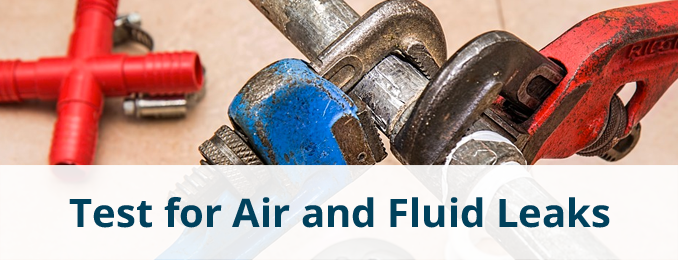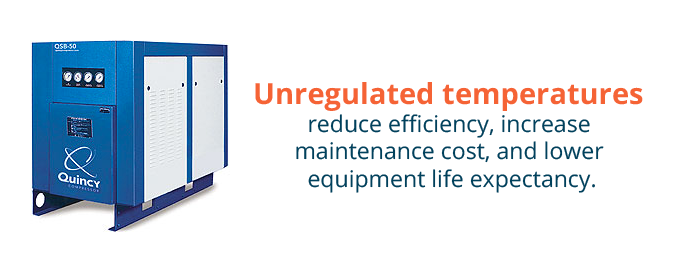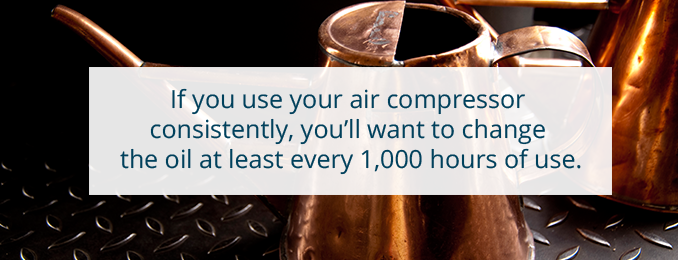
Your air compressor is a major part of your daily operations. That means you do a lot of little touch-ups or checks, but you might be neglecting major maintenance checks, which could harm your operations or end up costing you a lot of money in emergency repairs.
With a proper maintenance schedule, your air compressor can last for years and provide you thousands of hours of operation. Many people spring clean their homes each year, so we think it’s about time you also try a little air compressor spring cleaning.
We’ve created this air compressor maintenance checklist and a full set of tips to keep your air compressor running smoothly. Many air compressor checks should be performed each day, and before each operation, but these are smart additions to your maintenance schedule. Sometimes you’ll find a previously unknown problem when you perform a thorough check or a diagnostic review after the compressor has rested for a day or two.
Keep everything running at its best with this checklist, and be sure to ask Quincy Compressor if you have any questions about what checks to perform for your specific air compressor. Always consult the owner’s manual for the recommended schedule.
Quick Air Compressor Spring Maintenance
We’ll get into some of the more involved air compressor maintenance checklist items soon, but first we’ll start with a few of the options that you and your team can tackle quickly. We recommend that you observe each during the spring cleaning and make any process a more-common check if it seems like it may help catch a problem you’ve had in the past.
Monitor Incoming Voltage
It’s not the first place you’d think to check, but it’s very important. Make sure that the incoming voltage on your air compressor isn’t too high. Check the amps on the machine, as well. If you’re giving it too much juice, you could have a major failure that can cost your company a lot of money.
Test for Air and Fluid Leaks
Oil leaks can be simple to detect based on the area where your compressor normally runs. Air leaks can be a little more difficult, so listen for them and also try applying soapy water to certain leak areas (hoses, disconnects, shut-off values, condensate traps, etc.) and looking for bubbles that form.
If you have access to ultrasonic equipment, it can help you find even the smallest of leaks. The downside is that the equipment can be expensive and requires training for proper use. To learn more, check out our article on how to fix air leaks in air compressors.
Look at Your Differentials
Examine the differentials across your filter. The PSI you put in should be very similar to the PSI that it puts out. If you find a significant gap, it’s time to perform a thorough check on the parts of your equipment. Filters are a major area to test.
Monitor the Temperature
One of the top problems that air compressor operators face is a unit that overheats. This leads to reduced efficiency, increased maintenance costs and may cause you to replace the system earlier than its expected life. Temperature should be logged consistently to make sure the equipment is not overheating.
Check the cooler for proper function and ensure that it’s not becoming covered in dust. If it is, you’ll need to give the cooler a little more physical space.
Also, it’s a good idea to take a few minutes and ensure that your compressor has enough space to properly vent — this is exceedingly important during those hot summer months. Your compressor should have space to exhaust and not trap that hot air against its frame.
Ensure Only Good Vibrations
Check the vibration levels on the motor and the airend or pump to ensure that your unit is not exceeding standard vibration levels. This is smart to check on a consistent basis, but your team should also be on the lookout for warning signs throughout the year.
Vibration pads sit under a stationary air compressor and minimize its vibration to stop some shaking and minimize the potential for damage. Excessive noise often means you’ll need to check these, because worn pads can lead to the floor mounting becoming loose, your compressor starting to tilt and the casing or mounting bolts become loose.
Take Oil Samples
It’s always good to take an oil sample each year — preferably each quarter — to look for problems. You can check the oil to see if it needs to be replaced, (more on that below) but also for the presence of other items. Excessive sludge, grime or the presence of metal flakes can be a significant warning sign.
You may need to have a professional company test your oil samples, but the ounce of prevention is much cheaper than the pound of cure when it comes to replacing a system due to oil and coolant failures.
Look at Hoses and Intake Vents
A couple common places where problems crop up are the intake vents and the hoses of your air compressor. Dirty or clogged intake vents will damage your compressor. Give them a good scrubbing and blast them with a can of compressed air to keep dust away.
After that, take a peek at your hoses. If there are cracks or signs of corrosion, you could soon see a leak that will cause a lot of stress on your compressor. Replace them at the first sign of cracks, cuts or other damage.
A Good, Thorough Cleaning
Always give your air compressor a proper dusting, usually a few times each year. At the very least, make sure it’s part of your air compressor spring cleaning maintenance checklist.
Give your compressor a proper check each year. Start by looking at the compressor coolers and make sure they’re free from dust, oil and debris. Look at your connections for the presence of oil and check for outside debris finding its way under or into your air compressor.
Your heat exchangers are another place that can become dirty, reducing the compressor’s operating temperature. Give them a proper scrub to ensure a long life for your compressor.
We also recommend that you take time to clean up the entire area around the compressor. You’ll want to clean up oil and look for damage or debris that can lead to damage of your compressor, or potentially harm your employees as they work.
Changing Your Pump Oil
If your air compressor uses oil, a full replacement of that oil should be part of your spring maintenance. If you use your air compressor consistently, you’ll want to change the oil at least every 1,000 hours of use, though you can do it as often as 500 service hours.
Keep your compressor running smoothly and efficiently with a new batch of oil, completely removing and replacing the oil in your unit. Here are some tips on how to do that:
- Turn your air compressor off and unplug it, or otherwise remove it from the power source.
- Consult the owner’s manual for recommended fluid type and required amount.
- Let it rest for quite a while — the pump head and surrounding metal can become extremely hot during use.
- Check that the surface you’re working on is flat and level.
- Remove your fill cap and/or plug.
- Place a container underneath the oil drain cap, and make sure it’s large enough to hold more oil than your unit holds.
- Remove the oil drain cap — if you have to twist, it’ll be counter-clockwise — and let the oil drain out of your unit.
- Replace the oil drain cap and tighten it as securely as you can. We recommend you use plumbers’ tape to help create a proper seal.
- Fill your crankcase with the right amount of oil, which is usually denoted on the unit. Typically, you won’t want to exceed the halfway point of the sight glass, because oil expands with heat and you’re working with cool, dense oil right now.
This can also be a good time to check and change your separator element. This element prevents excessive oil from getting into the system, and it should be replaced roughly every 1,000 work hours.
Air Compressor Filter Spring Maintenance
Reciprocating air compressors need their air filter element looked over as part of every seasonal check, so that includes your air compressor spring cleaning to-do list. If you let them go too long without checking, they’ll start reducing the efficiency of your air compressor.
When efficiency declines, it takes more energy for your compressor to provide the right strength that your applications need. As energy increases, your costs increase. That means properly maintained filters can save you a lot of money each year.
These filters are relatively standard and easy to check. Here are some baseline steps, though the exact process for your air compressor’s filter may vary slightly. Remember, always take your time and consult your manual if you’ve reached a step or part that’s unfamiliar.
Checking the Filter Element
- Turn your air compressor off and unplug it, or otherwise remove it from your power source.
- Give your compressor plenty of time to cool down.
- Unscrew the filter top from your filter’s base. Typically, you’ll be turning it counter-clockwise.
- Once unscrewed, slowly pull and remove the filter top cover from the base. Look for wear or anything that’s out of place.
- Slowly remove the element that is located in the filter base.
- Inspect the element. You’ll usually need to blow the dust and other debris off of the filter element. This is best achieved with a can of compressed air or other low-pressure air. Too much air pressure or scrubbing can damage the element.
- If the element is cracked, worn or reached its recommended lifespan, replace it.
- Secure the cleaned or new filter into its base. Reconnect the filter top and screw it in tightly. Again, this is typically tightened by screwing clockwise.
One part that isn’t always standard is the drain on the filter. You want to make sure that there’s no clog or other obstruction, which can cause air leaks or expose your machinery to other liquid damage.
Drain the Compressor Tank
When you use your air compressor, it grabs air from the environment, which is often full of water vapor. As pressure builds up and compresses the air into your tank, water vapor gets compressed too and will slowly cut against the volume of air your compressor can compress.
Solve this by cleaning out the drain valve, usually located at the lowest point of your air compressor. Leave your compressor in its normal, upright position — turning it on its side can mean that you won’t clean out all the water.
- Place your air compressor in the normal position.
- Grip the ring on the compressor tank’s drain and turn it counter-clockwise.
- Make sure to open the drain valve all the way.
- Void the entire tank of the water, sludge, oil or even rust.
- Leave the valve open for a little help drying it out.
- Close the drain completely and ensure that its very tightly sealed.
Cleanup can vary. You can drain the tank into a can and find a place to get rid of all the sludge, or you can drain it onto the shop floor if you’ve got enough room to safely work around it. The water will slowly evaporate and you’ll be left with elements that you can sweep up.
Check Your Shutdown Options
Air compressors come with built-in safety shutdown options that can immediately halt its operation in the event of an emergency or major hazard. Typically, these will shut your compressor down if they become too hot or if the engine’s oil pressure drops dangerously low.
Review your compressor’s manual or contact us here to learn how to test this emergency shutdown option. Checking it at least once a year will help you verify the safety of your system. Smart maintenance and checks will keep your system running smoothly and ensure a long use-life, even if you face an emergency situation.
Setting Your Air Compressor Preventative Maintenance Schedule
When looking past your air compressor spring cleaning, it’s smart to consider creating a preventative maintenance checklist that you use ensure the health of your air compressor all year long. Here are just a few of the items you’ll want to consider.
We suggest printing this section out and laminating it if possible, then placing it near your air compressor.
Daily Tasks to Check Before Use
- Check the Pump Oil level
- Inspect for Oil Leaks
- Drain the tank of any water
- Test for unusual noise or vibration
- Inspect belts
- Test for air leaks
Weekly Items to Check
- Clean the air filter or replace it, if needed
Monthly Maintenance Tasks
- Inspect the safety relief valve
- Inspect connections for leaks
- Test your belts
- Check and tighten any bolts
Annual Tasks
- Service the pump and engine
- Run your air compressor and check its output
- Review all safety equipment and shutoff options
Contact Us Learn More Find a Dealer Near You
Get More Support from Your Local Quincy Team
Air compressor spring cleaning can sometimes come with dangerous surprises. If you’ve discovered a problem that you can’t solve, or need the right parts and equipment to perform maintenance, Quincy Compressor is here to help.
Use our service locator tool to find your local Quincy team member to get the help, parts and answers you need.





